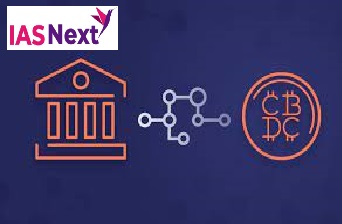CURRENT AFFAIRS
Get the most updated and recent current affair content on Padhaikaro.com
Central bank digital currency (CBDC)
- IAS NEXT, Lucknow
- 02, Dec 2021

Context:
The Reserve Bank of India has been working on a phased implementation strategy for a CBDC and the pilot may be launched by the end of this year.
The financial advisory services firm has listed four major use cases of CBDC in the Indian context. This includes:
- ‘Fit-for-purpose’ money used for social benefits and other targeted payments in a country. For such cases, the central bank can pay intended beneficiaries pre-programmed CBDC, which could be accepted only for a specific purpose.
- CBDCs could be used for faster cross-border remittance payments. International collaboration among the major economies of the world, including India, could help create the necessary infrastructure and arrangements for CBDC transfer and conversion.
- Payment instruments could be made available for payment transactions to be made via CBDC. Furthermore, universal access attributes of a CBDC could also include an offline payment functionality.
- Instant lending to micro, small, and medium enterprises (MSMEs) in India can be possible with the help of CBDC.
Need for CBDC:
- An official digital currency would reduce the cost of currency management while enabling real-time payments without any inter-bank settlement.
- India’s fairly high currency-to-GDP ratio holds out another benefit of CBDC — to the extent large cash usage can be replaced by CBDC, the cost of printing, transporting and storing paper currency can be substantially reduced.
- The need for inter-bank settlement would disappear as it would be a central bank liability handed over from one person to another.
What is the CBDC or National Digital currency?
A Central bank digital currency (CBDC), or national digital currency, is simply the digital form of a country’s fiat currency. Instead of printing paper currency or minting coins, the central bank issues electronic tokens. This token value is backed by the full faith and credit of the government.
SC Garg Committee recommendations (2019):
- Ban anybody who mines, hold, transact or deal with cryptocurrencies in any form.
- It recommends a jail term of one to 10 years for exchange or trading in digital currency.
- It proposed a monetary penalty of up to three times the loss caused to the exchequer or gains made by the cryptocurrency user whichever is higher.
- However, the panel said that the government should keep an open mind on the potential issuance of cryptocurrencies by the Reserve Bank of India.
Challenges in rolling out National Digital Currency:
- Potential cybersecurity threat.
- Lack of digital literacy of the population.
- Introduction of digital currency also creates various associated challenges in regulation, tracking investment and purchase, taxing individuals, etc.
- Threat to Privacy: The digital currency must collect certain basic information of an individual so that the person can prove that he’s the holder of that digital currency.